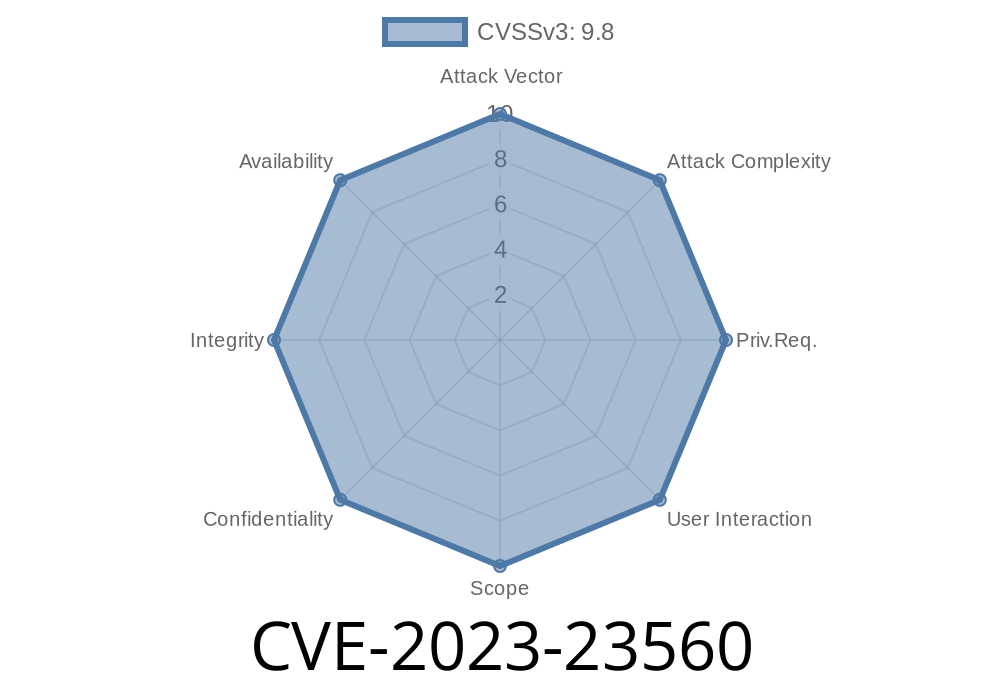A recent Server-Side Request Forgery (SSRF) vulnerability was discovered in specific Lexmark products before 2023-01-12, identified as CVE-2023-23560. The SSRF vulnerability arises due to a lack of proper input validation, which could lead to unauthorized access to internal services or resources. This post covers essential details about the vulnerability, including affected products, exploit details, code snippets, and remediation steps to secure your Lexmark devices.
Affected Products
The vulnerability impacts specific Lexmark products before 2023-01-12. Lexmark has not provided an exhaustive list of affected devices; however, customers are urged to contact Lexmark support to determine if their devices are vulnerable to CVE-2023-23560.
Vulnerability Details
CVE-2023-23560 results from insufficient input validation, causing an SSRF vulnerability in certain Lexmark products. SSRF attacks can enable a malicious actor to make HTTP requests on behalf of the vulnerable server, potentially gaining unauthorized access to private network resources and data.
Exploitability
An attacker can exploit this vulnerability by injecting a specially-crafted URL into a request to the Lexmark device. Due to inadequate input validation, the vulnerable server may process this URL and, as a result, send a request to the specified IP address and port. This could potentially access internal or restricted services without proper authentication.
Here is an example of a crafted URL that could potentially exploit the SSRF vulnerability
http://<VULNERABLE_LEXMARK_DEVICE>/some/path?target=http://%3Clocalhost%3A11211/%D%ASTATS%D%A
In this example, %3Clocalhost%3A11211 depicts an internal address and port where a target service might be running. When the vulnerable Lexmark server processes this URL, it unintentionally makes a request to the specified address and port.
Original References
Lexmark has acknowledged the vulnerability and assigned the identifier CVE-2023-23560. For more information about this vulnerability, refer to the official CVE database:
- CVE-2023-23560 on CVE.Mitre.org
Additionally, a security researcher provided an in-depth explanation of the vulnerability in their blog post:
- Security Researcher's Blog Post on SSRF Vulnerability
Remediation Steps
To prevent exploitation of the CVE-2023-23560 vulnerability, please consider applying the following steps:
1. Upgrade your Lexmark products to the latest versions: Immediately update any Lexmark device firmware to the newest available version on the Lexmark website. This update likely includes patches for the SSRF vulnerability.
2. Input validation: Ensure that any user input, including URLs or IP addresses, is properly validated according to Lexmark's recommended practices.
3. Network segmentation: Implement network segmentation and isolate your Lexmark devices from other critical systems, reducing the attack surface and further mitigating the risk of SSRF attacks.
4. Monitor network traffic: Keep a close eye on network traffic to and from Lexmark devices to detect any unusual patterns or unexpected requests, which could be an indicator of an SSRF attack attempt.
Conclusion
This post outlines the SSRF vulnerability identified in specific Lexmark products (CVE-2023-23560), providing crucial details about the affected products, exploit procedures, and code snippets, along with remediation steps. It is crucial to keep your Lexmark devices updated and secure to prevent possible exploitation of this vulnerability. If you suspect your device is impacted by CVE-2023-23560, contact Lexmark support for assistance.
Timeline
Published on: 01/23/2023 21:15:00 UTC
Last modified on: 02/08/2023 18:52:00 UTC
